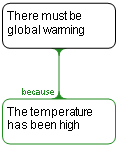The Science Of Scientific Writing Set 2 Set 2 - Indicator words : 3 types of Indicators : Example : Exercise 1 : Exercise 2 : Exercise 3 : Exercise 4 : Exercise 5 : Exercise 6-Quiz : Exercise 7 : Final page Set 2.
OVERVIEW: The way to well-written science
PART I: Paragraphs and Sentences
SET A: Paragraphs: The Maps Behind Them
SET B: Paragraphs: Using Maps to Meet Readers' Expectations
SET C: Paragraphs with Something Extra: Points and Tails
SET D: The Generic Section: Expectations and Maps as Blueprints
SET E: Scientific Sections: The Methods and Results
SET F: Scientific Sections: The Discussion
SET G : Scientific Sections: The Introduction
SET H : Sentences
SET I : The Paper as a Whole
PART II: The Paper and its Sections
SET 1: Argument Parts
SET 2: Indicator Words
SET 4: Locating Arguments in Prose
SET 5: Rationale's Essay Planner
SET 6: Evidence in Arguments: Basis Boxes
Synthesis 1: Position-Early Paragraphs
Synthesis 2: Position-Final Paragraphs
Synthesis 3: Writing a Discussion I
Synthesis 4: Writing a Discussion II
Now we'll move on to mapping arguments on the workspace, using indicator words to help with this process.
Up until now you've been dragging boxes onto the workspace, but you can also drag text the same way. To drag text, highlight the portion you want, hold the mouse button down, and drag the text onto the workspace.
Example
Consider the following short argument:
'The temperatures have been high, therefore there must be global warming'.
The indicator word reveals that we would map the argument like this:

Here's how we arrived at this map.
Content of this page drawn in whole or part from the Austhink Rationale Exercises with permission from Austhink .